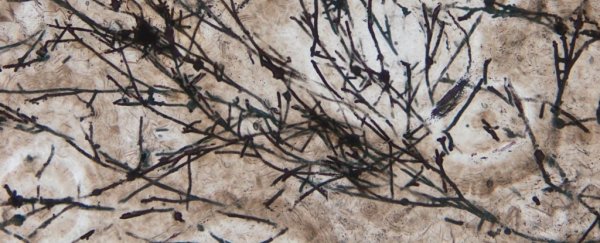An international team of scientists in South China accidentally discovered the oldest terrestrial fossil ever found, about three times more ancient than the oldest known dinosaur.
Investigations are still ongoing and observations will need to be independently verified, but the international team argues the long thread-like fingers of this ancient organism look a lot like fungi.
Whatever it is, the eukaryote appears to have fossilised on land roughly 635 million years ago, just as Earth was recovering from a global ice age.
During this massive glaciation event, our planet resembled a big snowball, its oceans sealed from the Sun by more than a kilometre (0.6 miles) of solid ice. And then, in a geologic 'flash', our world began to inexplicably thaw, allowing life to thrive on land for the first time.
Fungi might have been among the first life forms to colonise that fresh space. The date of this new microfossil certainly supports the emerging idea that some fungi-like organisms ditched the oceans for a life on land even before plants.
In fact, this transition might have been what helped our planet recover from such a catastrophic ice age.
"If our interpretation is correct, it will be helpful for understanding the paleoclimate change and early life evolution," says geobiologist Tian Gan, from the Virginia Tech College of Science.
Today, the early evolution of fungi remains a big mystery, in large part because without bones or shells, these organisms do not fossilise easily. Not too long ago, many scientists didn't even think it was possible for fungi to last that long.
The genome of modern-day fungi suggests their common ancestor lived over a billion years ago, branching off from animals at that time, but unfortunately, there could be a 600 million year break before the first obvious fungi fossil shows up in our records.
In recent years, a stream of intriguing and contentious discoveries have helped bridge that gap.
In 2019, scientists reported the discovery of a fungi-like fossil in Canada, which had fossilised a billion years ago in an estuary. The implications were huge - namely that the common ancestor of fungi may have been around much earlier than the common ancestor of plants.
In 2020, a similar fossil with a resemblance to fungi was found in the Democratic Republic of Congo, and it was fossilised in a lagoon or lake between 810 and 715 million years ago.
Controversy still exists over whether or not these ancient organisms were actually fungi, and the new microfossil found in China will no doubt spur similar debate. After carefully comparing the organism's features to other fossils and living life forms, the authors identify it is a eukaryote and "probable fungi".
"We would like to leave things open for other possibilities, as a part of our scientific inquiry," says geoscientist Shuhai Xiao from Virginia Tech.
"The best way to put it is that perhaps we have not disapproved that they are fungi, but they are the best interpretation that we have at the moment."
That said, the new discovery provides more evidence that fungi-like organisms may have predated plants on land.
"The question used to be: 'Were there fungi in the terrestrial realm before the rise of terrestrial plants'," explains Xiao.
"And I think our study suggests yes."
The next question is: How did that fungi survive?
Today, many species of terrestrial fungi are incapable of photosynthesis. As such, they rely on a mutualistic relationship with the roots of plants, exchanging water and nutrients from rocks and other tough organic matter for carbohydrates.
Because of this relationship, it was thought that plants and fungi emerged together to help populate the land. But the oldest terrestrial plant fossil only dates to 470 million years ago.
The recently unearthed fungi-like microfossil is much older than that and was found hidden within the small cavities of limestone dolostone rocks, located in the Doushantuo Formation in South China.
The rock in which the fossil was found appears to have been deposited roughly 635 million years ago, after our snowball Earth had melted. Once open to the elements, the authors suspect carbonate cement began to fill in the cavities between the sheets of limestone, possibly entombing the micro-organisms living inside these bubbles.
These fungi-like life forms might even have roomed with other terrestrial micro-organisms, which were also widespread at the time, such as cyanobacteria or green algae.
If fungi-like animals were equally ubiquitous, then it's possible these life forms helped accelerate chemical weathering, delivering phosphorus to the seas and triggering a wave of bioproductivity in the marine environment.
On land, they might have even helped unearth clay minerals for carbon sequestration in Earth's soil, making a fertile environment for plants and animals and possibly changing the very atmosphere of our planet.
"Thus," the authors conclude, "the Doushantuo fungus-like micro-organisms, as cryptic as they were, may have played a role in catalyzing atmospheric oxygenation and biospheric evolution in the aftermath of the terminal Cryogenian global glaciation."
The study was published in Nature Communications.
